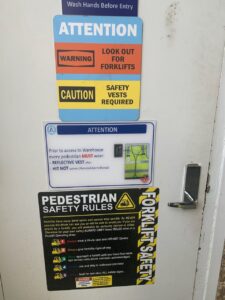Did you know that injuries such as broken bones, burns, amputations, and toxic chemical inhalation occur daily in warehouses? While these incidents might sound like scenes from a horror movie, they are the harsh realities warehouse workers face globally. Many of the injuries are avoidable with the right precautions. Tackling the biggest warehouse safety issues extends beyond merely ticking a box on a checklist. It’s about establishing a pocket of safety for workers and ensuring seamless operations.
Common Warehouse Hazards
Warehouses are hubs of activity, where potential hazards are plentiful. Recognizing these risks is the first step in establishing safety precautions and fostering a secure work environment.
 Slips and Falls
Slips and Falls
Slips and falls consistently rank at the top of warehouse workplace injury lists often due to uneven floors, wet surfaces, and unmarked hazards. The National Safety Council (NSC) reports that falls rank third in preventable injury-related workplace deaths (NSC). To combat this, implementing rigorous housekeeping practices, appropriate flooring, and quickly cleaning up spills can drastically reduce the likelihood of accidents.
Forklift Accidents
Forklift operation comes with risks. Accidents often result from inadequate training, poor visibility, and insufficient pedestrian safety measures. According to the Occupational Safety and Health Administration (OSHA), forklifts are responsible for over 70 fatalities and around 8,000 serious injuries in the U.S. each year. Enhancing safety with clearly marked pathways, designated work areas, in-depth forklift training, speed limit enforcement, and proximity alert systems can greatly minimize these accidents.
Ergonomic Issues
Repetitive motions and improper lifting techniques contribute to long-term musculoskeletal issues. These issues impact employee health and may result in decreased productivity. The Bureau of Labor Statistics (BLS) indicates that musculoskeletal disorders like carpel tunnel syndrome and muscle strains account for nearly 30% of workplace injuries requiring time off. Offering ergonomic training and tools like lifting aids and adjustable workstations can effectively address these concerns.
Fire and Electrical Safety
Improper storage of flammable materials and faulty wiring can lead to catastrophic fire hazards in warehouses. The National Fire Protection Association (NFPA) highlights that electrical failures or malfunctions account for 18% of warehouse fires. Regular maintenance of electrical systems and safe storage protocols for hazardous materials are fundamental for preventing fires and ensuring a safe environment.
Safety Regulations
Adhering to safety regulations is non-negotiable for maintaining a secure and compliant workplace. These guidelines provide a structured framework to lower risk and boost overall safety.
OSHA Guidelines:
- Compliance with OSHA regulations covers various aspects like equipment operation, hazard communication, and workplace safety. Conducting regular safety audits and aligning with OSHA standards are critical for risk mitigation. Demystify OSHA by educating employees on key OSHA guidelines, making those guidelines accessible, and establishing safety committees to monitor and enforce compliance.
Learn more about OSHA safety guidelines.
Training and Awareness:
- Ongoing training and cultivating a culture of safety awareness are vital for proactive safety management in warehouses. Regular safety drills, workshops, and updates on safety protocols empower employees to act preventively. Effective training programs instill a culture where safety is a collective responsibility, enhancing vigilance, and adherence to safety practices.
Reporting and Record-Keeping:
- Efficient reporting systems are key for real-time evaluation and improvement of safety procedures. Detailed record keeping of incidents and near-misses allows management to identify patterns and implement preventive measures successfully. Reports aren’t simply paperwork; they serve as blueprints for calculated safety improvements.
Innovative Warehouse Safety Solutions
Harnessing modern technology and innovative solutions elevates warehouse safety beyond traditional measures.
Advanced Technology
You need more than hard hats to keep your employees safe.
- Vine Emergency Alert Systems: This level of advanced technology enables rapid distribution of information and evacuation instructions during emergencies like gas leaks. It is an emergency alert capable of sending mass notifications in time-sensitive situations. Essentially, it can help ensure swift and coordinated responses.
- Proximity Alert System: This technology provides real-time driver alerts and pedestrian alerts. It helps to prevent collisions and improve safety awareness around vehicles.
- Modjoul Smart Belt: This is a wearable device that tracks repetitive motion. It helps with potential injury prevention related to repetitive tasks through real-time monitoring and haptic feedback.
 High Visibility Gear and Signage
High Visibility Gear and Signage
Although they may seem basic, safety vests and signs are important for maintaining order and safety in a bustling warehouse. Just think of the chaos and confusion that would occur inside a warehouse without brightly colored vests and informational signs. Scary right?
- High-Visibility Gear: Fluorescent vests and gloves aren’t fashion statements. They are high-visibility gear and safety shields that make workers visible and reduce accident risks.
- Strategic Signage: Clear, well-placed signage directs traffic, outlines work zones, and marks potential hazards.
Tailored Safety Programs
One size doesn’t always fit all. That certainly rings true as it concerns safety initiatives. These programs should focus on addressing:
- Unique operational risks
- Ensuring comprehensive protection
- Specific profile of the warehouse
Here is OSHA’s Recommended Practices for Safety and Health Programs.
Employee Involvement
Active employee engagement in safety initiatives develops a sense of ownership and accountability.
- Employee Empowerment: Encourage staff to suggest improvements and lead safety drills. This can help to heighten engagement and compliance. Platforms for idea-sharing, safety committees, and employee recognition/rewards for safety achievements contribute to a culture of safety and accountability. This should foster proactive participation.
Tackling the biggest warehouse safety issues requires a multi-faceted approach. Adhering to OSHA guidelines, conducting ongoing training, and maintaining a robust safety reporting system form the backbone of a protected warehouse environment.
Remember, common warehouse hazards, safety regulations, and solutions are deeply intertwined. Likewise, you must consistently re-evaluate and update your warehouse safety protocols. Safety is more than compliance; it’s an investment in the well-being of your workforce and the overall efficiency of your operations.
If you are ready to tackle your warehouse safety issues, please contact the knowledgeable SynTech team at (256) 571-5024. We have over 40 years of experience providing training and equipment to work sites. We are also the #1 sales and service provider of poximity alert systems. Let us help you protect your people and property.